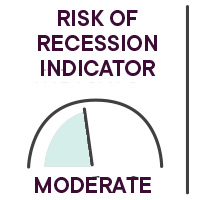Yann Furic
B.B.A., M. Sc., CFA®
Senior Portfolio Manager, Asset Allocation and Alternative Strategies
What moved the markets:
Growth in U.S. markets and weakness in the Canadian market.
Gradual slowdown in the U.S. and Canadian economies.

|
OVERVIEW OF GLOBAL EQUITY MARKETS |
||||
|
Country |
Index |
Return |
Change |
Year-to-date |
|
Canada |
S&P/TSX |
-1.42% |
|
6.05% |
|
United States |
S&P 500 |
3.98% |
|
19.64% |
|
|
Nasdaq |
6.44% |
|
23.04% |
|
International Stock Markets |
EAFE |
-1.24% |
|
9.31% |
|
Emerging markets |
|
4.34% |
|
11.54% |
|
China |
MSCI China |
-1.52% |
|
8.69% |
The return shown is the total return which includes the reinvestment of income and capital gains distributions.
Source: Morningstar Direct.
Results – Canadian bonds
The FTSE Canada Universe Bond Index, which includes Canadian government and corporate bonds, has posted a negative return of 0.38% year to date (at June 28, 2024).
(Source: Morningstar Direct)
Our analysis of events

One or more further rate cuts?
- In early June, the Bank of Canada cut its policy rate for the first time, by 0.25%. The market is currently anticipating two further cuts in 2024.
- However, if the Bank of Canada cuts its rates and the Fed doesn’t move, the consequences of this dichotomy could lead to a significant devaluation of the Canadian dollar. The market’s baseline scenario is currently for two rate cuts in the U.S., and two more in Canada by the end of 2024.
- At its June 12 meeting, the U.S. Federal Reserve (Fed) kept its key rate at its current level (5.25% to 5.50%), pending more definitive confirmation of recent trends. A first rate cut could now be announced in September, inflationary pressures permitting; if not, it will probably be announced at the Fed’s November meeting, a few days after the U.S. elections, so that the Fed could not be accused of favouring one candidate over another.
Inflation rates: what’s new?
- The rate of inflation and how quickly it falls remain the two variables with the most direct impact on the markets at present.
- Canada’s annual inflation rate was 2.9% in May, up from the previous month and above market expectations. In the United States, the rate fell to 3.3% in May, below market forecasts.
Scenarios still possible between now and the end of 2024
- The most positive scenario remains a rate cut due solely to a decline in inflation, with no pronounced economic slowdown.
- A strong U.S. economy, requiring fewer rate cuts, could favour the U.S. dollar, which would appreciate against other currencies. Such a situation would negatively impact the Canadian dollar and keep inflation higher in Canada.
- The last and most feared scenario would see reaccelerating inflation, with a rapidly deteriorating economic situation, leading to stagflation.
International situation: politics in the news
- The results of the European elections prompted the French government to call an election. The current results show that no party holds a majority, which will make the country difficult to govern.
- Elections in England have given victory to the Labour Party, which has returned to power after a 14-year drought.
Have consumers decided to rein in their spending?
As the maturities of various consumer and business loans draw nearer, we may see a significant reduction in spending by both consumers and businesses, for fear of being squeezed by much higher-than-anticipated interest rate payments. This abrupt contraction in spending could reduce the level of inflation, but could also push the economy into recession.
In Canada, the central bank’s primary mandate is to contain inflation, while in the U.S., the Fed must also take the labour market into account.
In both countries, the employment situation has deteriorated in recent months. This consequence of the policies adopted by central banks has had the effect of limiting wage inflation, although it is still high, and may also enable the Fed to cut its rates in the near future.
Central banks must therefore continue their delicate balancing act between keeping rates too high, which would eventually push the economy into recession, and cutting rates too quickly, which would stimulate the economy and create an increase in demand and, by extension, prices, thus triggering a return of inflation.
Employment situation
In Canada, the unemployment rate was 6.4% in June, up from the previous month. The number of jobs fell by 1,400, well below expectations for the creation of some 25,000 jobs. Hourly wage growth remained too high, and was clearly faster than expected, rising by 5.6% on an annual basis. For several months now, and despite a confirmed increase in the number of jobs created, Canada’s high level of immigration remains the main reason for the steady rise in the unemployment rate.
The latest U.S. employment data came as a surprise, with 206,000 jobs added, versus expectations of 190,000. The unemployment rate rose to 4.1%, also higher than expected. Job creation data for recent months have been revised downwards, inflating the unemployment rate. Wage growth, meanwhile, remains too high at 4.1%, up from the previous month.
Economic indicators
Global Purchasing Managers’ Index ![]()
Manufacturing segment indicators continue to hold firm, with nearly half of the 30 countries posting an index reading above 50 (which signals an expansion).
Inflation rate ![]()
Overall, inflation remains too high to allow for significant rate cuts. However, it seems to be moving in the right direction.
Benchmark rates in Canada, Europe and the United States ![]()
Interest rates have been stuck at high levels for some time now. Imminent personal and business loan renewals could force consumers and businesses to reduce their spending now, in anticipation of higher rates than initially expected.

Our strategic monitoring
We are monitoring inflation as well as the leading indicators for manufacturing production, the services sector, employment and consumer spending.
Caution and risk management remain our priorities.
Our tactical approach
In June, we reduced the weighting of equities in the tactical allocation strategy, with the economic outlook and market indicators still dictating an overweight position, albeit less pronounced.
In the United States, we maintained our position in large cap growth stocks, which react positively to stabilizing interest rates, as well as in stocks with a track record of dividend growth which are more defensive.
We kept a reduced position in small cap stocks, which react well to rate cuts, now postponed to later in the year. We maintained our position in emerging markets stocks, which respond positively to improved global economic conditions.
We remain overweight Japan relative to Europe. The Japanese economic outlook seems brighter to us, but we hedged part of our exposure to the yen, which remains weak.
In the fixed-income component, we increased our existing biases and took a new position in the issues of emerging economies, which are showing attractive economic growth.
We continue to favour stocks in developed countries and focus on risk management.
To learn how our funds performed:
Main risks
- An overly restrictive monetary policy could cause a major recession or other problems, like the U.S. regional bank crisis.
- High interest rates for an extended period would reduce corporate profits and sharply curtail household spending.
- The possibility of an episode of stagflation, i.e. anemic economic growth and high inflation, persists. This situation is negative for stock markets.
- The Israeli-Palestinian conflict could have repercussions throughout the Middle East.
- An escalation of the conflict in Ukraine could spread to other European countries.
- There is also a risk of worsening tensions between China and the United States over Taiwan.
Senior Manager, Asset Allocation and Alternative Strategies
Data source : Bloomberg
The opinions expressed here and on the next page do not necessarily represent the views of Professionals’ Financial. The information contained herein has been obtained from sources deemed reliable, but we do not guarantee the accuracy of this information, and it may be incomplete. The opinions expressed are based upon our analysis and interpretation of this information and are not to be construed as a recommendation. Please consult your Wealth Management Advisor.









